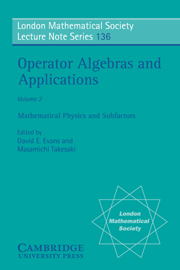Book contents
- Frontmatter
- Preface
- Contents
- UK-US Joint Seminar on Operator Algebras Lectures
- Some recent results for the planar Ising model
- The heat semigroup, derivations and Reynolds' identity
- C*-algebras in solid state physics: 2D electrons in uniform magnetic field
- Spin groups, infinite dimensional Clifford algebras and applications
- Subfactors and related topics
- Quantized groups, string algebras, and Galois theory for algebras
- On amenability in type II1 factors
- An index for semigroups of*-endomorphisms ofB(H)
- Coactions and Yang-Baxter equations for ergodic actions and subfactors
- Derived link invariants and subfactors
Coactions and Yang-Baxter equations for ergodic actions and subfactors
Published online by Cambridge University Press: 16 March 2010
- Frontmatter
- Preface
- Contents
- UK-US Joint Seminar on Operator Algebras Lectures
- Some recent results for the planar Ising model
- The heat semigroup, derivations and Reynolds' identity
- C*-algebras in solid state physics: 2D electrons in uniform magnetic field
- Spin groups, infinite dimensional Clifford algebras and applications
- Subfactors and related topics
- Quantized groups, string algebras, and Galois theory for algebras
- On amenability in type II1 factors
- An index for semigroups of*-endomorphisms ofB(H)
- Coactions and Yang-Baxter equations for ergodic actions and subfactors
- Derived link invariants and subfactors
Summary
Introduction
The aim of this paper is to bring into evidence the usefulness of considering not only actions of compact groups on operator algebras, but also the dual notion of coaction. A lot of what we shall say is contained in much greater detail in three series of papers, due to be published in the near future: four papers on ergodic actions, two on product type actions and two on equivariant K–theory. These all have their rather primitive origins in the three chapters of my thesis. The other main proponent of coactions of compact groups is Adrian Ocneanu, and we shall make frequent reference to his still unpublished work.
We now briefly summarise the contents of the rest of this paper. In Section II we recall the basic definitions of coactions of compact groups on von Neumann and C* algebras. We present two examples of C* algebras which arise perhaps unexpectedly as crossed products by coactions, and show how this observation can be used to explore their structure. The basic idea here is an old one: to use symmetry properties to simplify and elucidate computations. In Section III we exhibit two general principles in equivariant KK–theory, namely Frobenius Reciprocity and Dirac Induction. When combined with the equivariant Thorn isomorphism, these lead to a generalisation of a spectral theorem of Hodgkin (for the K–theory of spaces) which in principle provides a homological machine whereby ordinary KK-theory (of a pair of algebras) can be deduced from equivariant KK–theory.
- Type
- Chapter
- Information
- Operator Algebras and Applications , pp. 203 - 236Publisher: Cambridge University PressPrint publication year: 1989
- 13
- Cited by



